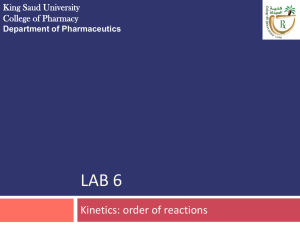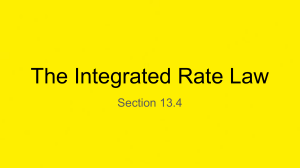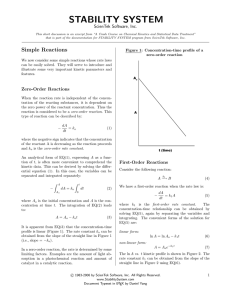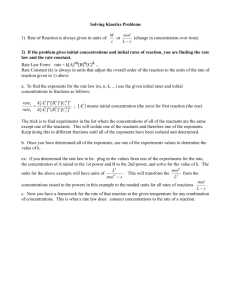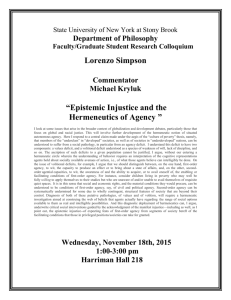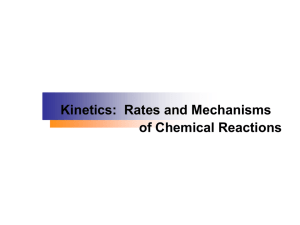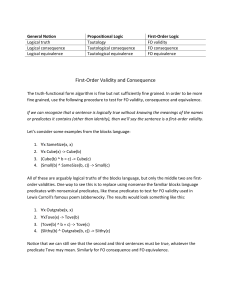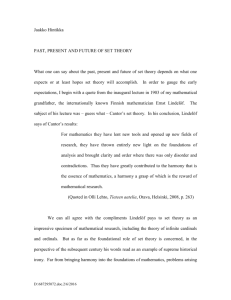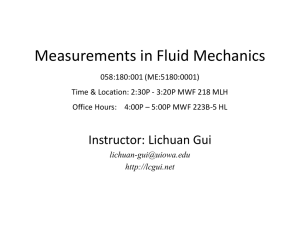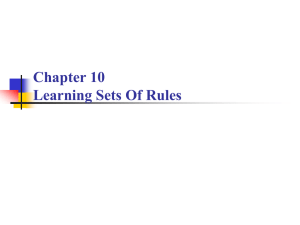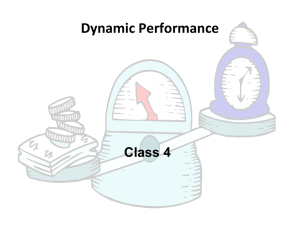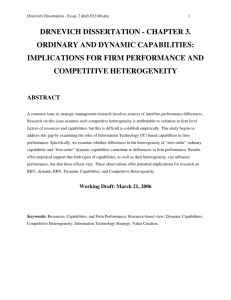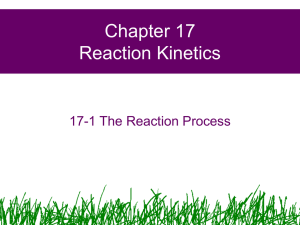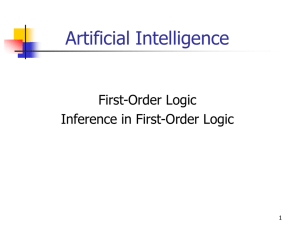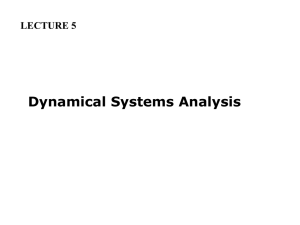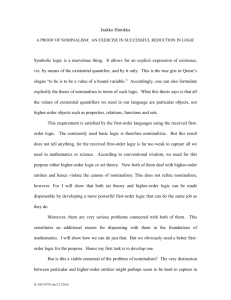BIOLOGICAL - Kinetics
advertisement
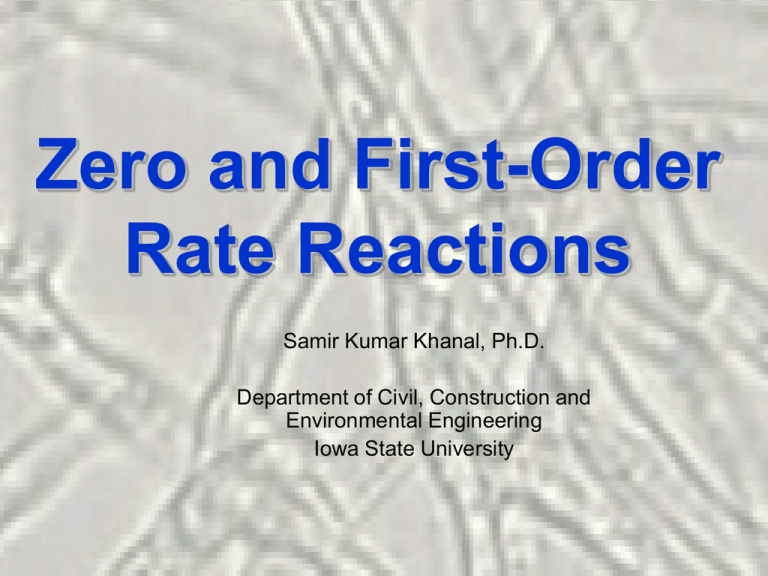
Zero and First-Order Rate Reactions Samir Kumar Khanal, Ph.D. Department of Civil, Construction and Environmental Engineering Iowa State University Question!! Assume you are a process engineer (biological), newly recruited by P & G. In your first week of job, you have been assigned to assist in the design of a bioreactor for growing edible fungi on synthetic growth medium to produce light-weight protein diet for astronauts. How are you going to design? Specifically what data do you need? Call your professor? Ask the senior engineer? Surf the internet? Consult BSE 482: lecture notes Before you start designing a bioreactor (fermentor), you must have clear understanding of the followings: How fast the fungi are able to convert the organics into protein? That is bioconversion rate or reaction rate or kinetics. (C2-C1)/(t2-t1) = dC/dt When is the reaction going to be over? “t” Which bioreactor configuration would be ideal? Suspended growth Attached growth At the end of this class, you should be able to define biochemical kinetics, reaction rate and order derive the rate of a reaction in terms of the appearance of products or disappearance of reactants describe the basic factors that influence the rate of a reaction integrate the rate laws for 0, and 1st order reactions determine the rates and orders of the biochemical reactions explain the practical significance of reaction rate and order Reaction Rates • Definition – change in concentration of a reactant or product with time rate C t C 2 C1 t 2 t1 • The rate will be negative (-) for reactants • The rate will be positive (+) for products Reactants: mostly pollutants (we want to get rid of), e.g. nitrate, phosphate, organics, pesticides, etc. Products: mostly value-added commodities (we want to produce), e.g. protein, lactic acid, enzymes, nisin, yeast, etc. The basic requirements are: 1. A good thermostat as rates change with temperature C1 -dC/dt= (C1-C2)/(t2-t1) C1 C2 (A) The rate of decrease in concentration of a reactant, or (B) The rate of increase in concentration of the products. Concentration mg/L Determination of biological reaction rate: C2 t1 3. A method of determining the concentration of reactant or product. Determined by measuring the concentration of a reactant or product as a function of time during the course of a biological reaction Concentration mg/L 2. An accurate timing device (stopwatch) t2 C2 C1 dC/dt= (C2-C1)/(t2-t1) t1 t2 Factors affecting the speed or rate of a biological reaction Concentration Temperature Presence of a macro/micro-nutrients Physical state of reactants Effect of Concentration on Reaction Rate Rate ( Concentrat ion ) n = reaction order usually an integer (e.g. 0, 1, 2) n ln rate n ln concentrat ion 2nd order n =2 The order of a reaction refers to the powers to which concentration are raised 1st order 2 n =1 ln (rate) 1 1 1 Zero order n=0 ln (conc.) “A second-order “A first-order zero-order reaction is one in reaction is one in which the rate of which the rate of reaction is directly reaction is directly proportional to the independent to proportional of square of the concentration.” concentration.” What does reaction order tell us?? Relationship between rate and concentration! How the amount of compound speeds up or retards the reaction rate! Zero-Order Reactions d [C ] [C ] n dt d [C ] k [C ] n k = rate constant dt For zero-order reaction, n = 0 d [C ] k dt C C0 t dC k dt 0 Negative means, [C] decreases with time unit of k is mass volume-1 time-1 C C 0 kt C C 0 kt If [C] increases with time (for product formation) Graphical representation of zero-order reaction C C 0 kt C C 0 kt y c mx Reaction rate (slope) remains constant Slope = -k Zero-order reactions: not very common in biological engineering C C0 Time Some examples of zero-order reactions Biodegradation of 2,4-D (2,4-Dichlorophenoxyacetic acid) Ammonia oxidation to nitrite Biodegradation of aromatic hydrocarbons in compost Phenol degradation by methanogens First-Order Reactions d [C ] [C ] n d [C ] dt k [C ] n dt For first-order reaction, n = 1 d [C ] kC dt ln C C0 k = rate constant kt C dC C0 C or C t k dt 0 e C0 ln C ln C 0 kt or Which is similar to a straight line equation kt Negative means, [C] decreases with time unit of k is time-1 C C0 e kt ln C ln C 0 kt y c mx Graphical representation of first-order reaction ln C ln C 0 kt y c mx C0 ln C0 C ln C First-order reactions: very common in biological engineering Some examples of first-order reactions Degradation of chlorinated compounds Microbial growth (bacteria/fungi) Oxidation of organic matter O rg a n ic m a tte r (C ), m g /L 200 150 100 50 0 0 5 10 T im e , h r 15 Comparisons of zero and first-order reactions Zero-Order O rg a n ic m a tte r (C ), m g /L 200 First-Order 150 100 50 0 0 5 10 T im e , h r 1. How the reaction changes with time. 2. What about change in slope (k)? 3. What is the unit of k in each case? 4. What is the effect of concentration? 15 Example: An engineering student was interested in the biodegradation of atrazine in an aqueous environment, its reaction rate and order. She went to the lab and conducted a series of batch tests in shaker flasks at 25oC using an enriched microbial culture of Pseudomonas. During her experiments, she collected data every alternative day. The data are shown in the table below. Time, days 0 Atrazine, mg/L 18 ln (C) 2.890 5 15 2.708 12 11 2.398 22 6.8 1.917 31 4.2 1.435 40 2.6 0.956 50 1.5 0.405 60 0.8 - 0.223 3 .5 y = - 0 .0 5 1 9 x + 2 .9 8 7 1 3 R 2 .5 15 2 = 0 .9 9 6 5 2 ln (C ) A tra zin e c o n c e n tra tio n , m g /L 20 10 1 .5 1 0 .5 5 0 0 -0 .5 0 20 40 60 0 10 Zero-order k 30 T im e , d a y s T im e , d a y s d [C ] 20 First-order d [C ] kC dt dt C = Co- kt ln (C) = ln (Co)- kt y = 2.9871- 0.0519x 40 Effect of temperature on biological reaction rate The effect of temperature on reaction rate is given by the Arrhenius equation: EA= activated energy, J/mol R = Universal gas constant 8.31J/mol-K T = Temperature in Kelvin = (oC + 273) A = Constant (not significantly affected by small temp. change What happens if you increase the temperature by 10°C from, say, 20°C to 30°C (293 K to 303 K)? Let's assume an activation energy, EA of 50,000 J mol-1. gas constant, R, is 8.31 J K-1 mol-1. k Ae At 20°C (293 K), the value of the fraction: e E RT e E RT At 30°C (303 K), the fraction is: 50 , 000 8 . 31 x 293 1 . 21 x10 9 e E RT e 50 , 000 8 . 31 x 303 2 . 38 x10 Rule of thumb: Rate of a reaction doubles for every 10 degree rise in temperature 9 For biological reactions, this role will hold more or less true up to a certain optimum temperature kT2 Activities of mesophilic methanogens at different temperature Temperature correction for rate constant k T 2 k T 1 ( T 2 T 1) : temperature-activity coefficient: 1.034 – 1.08
